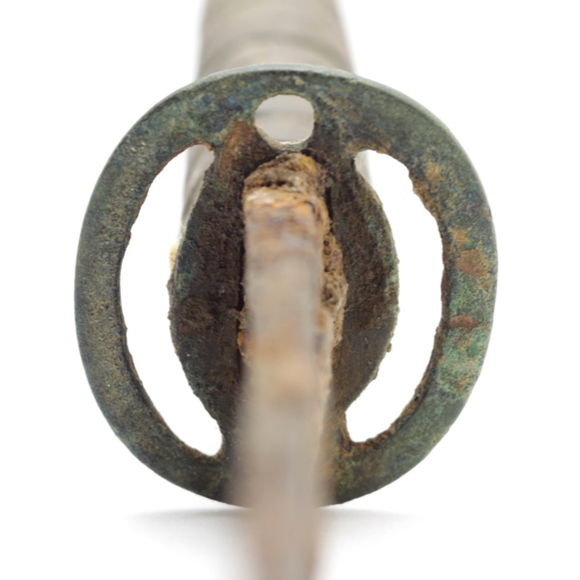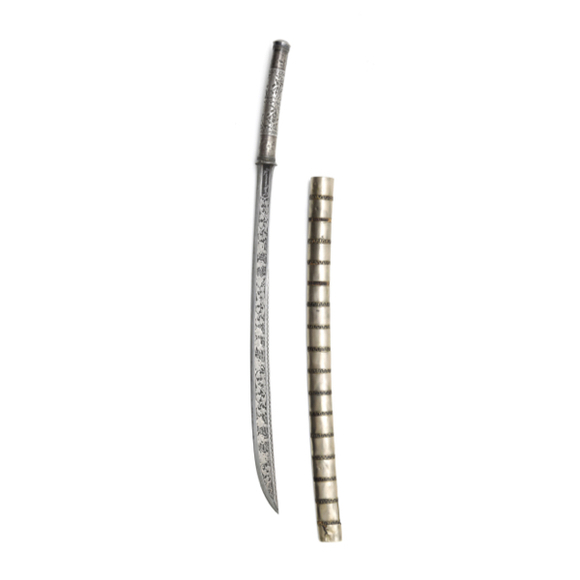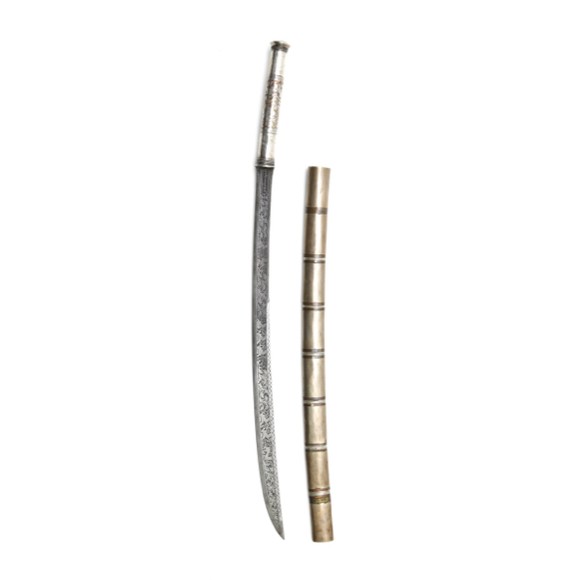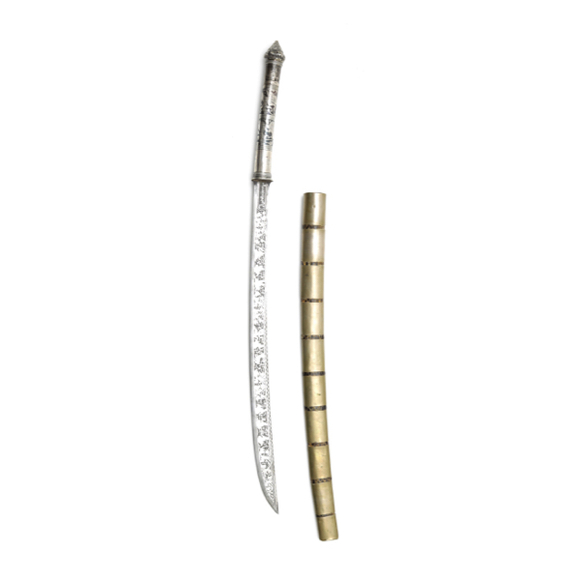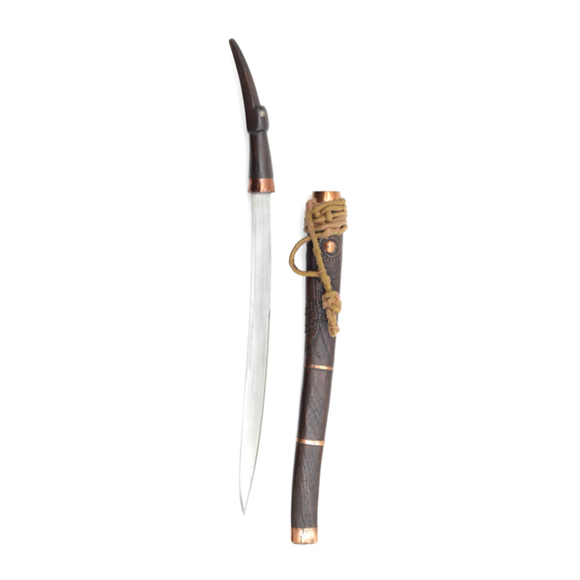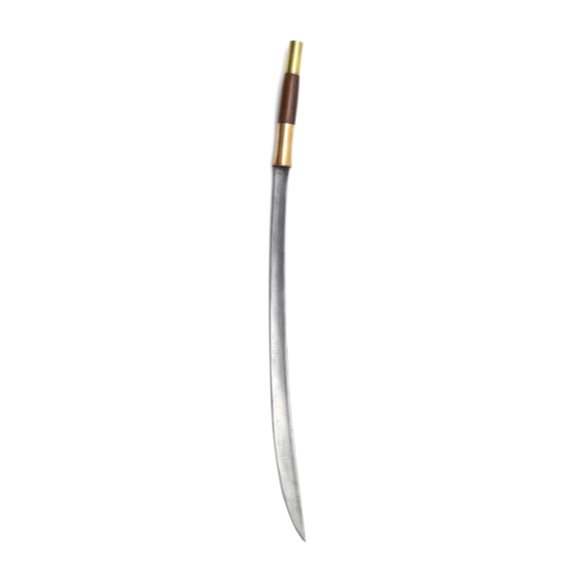In excavated condition, with copper alloy hilt.

Sheathed 88 cm
Sword 81.3 cm
46.5 cm
Base 7 mm
Middle 4.5 mm
5 cm from tip 2.5 mm
Base 23 mm
Middle 17 mm
5 cm from tip 13 mm
404 grams
3 mm fom guard
Iron, copper alloy, wood, resin
Southeast Asia, probably Vietnam
68.3% probability
1640 AD - 1672 AD (42.7%)
1778 AD - 1799 AD (25.6%)
95.4% probability
1528 AD - 1550 AD (3.5%)
1634 AD - 1684 AD (48.4%)
1735 AD - 1804 AD (39.7%)
European antique market
Introduction
Various styles of Southeast Asian dha are circulating, in excavated condition. These are in my opinion a mixed bag of fakes and genuine pieces, all of uncertain origin. For many of the styles, it is hard to pinpoint them to a specific date, so when I got my hands on two that contained wood I went and had them carbon dated.
I am excited to be presenting this sword with the results of scientific analysis. These tests are so costly as to render the project entirely unfeasible from a commercial perspective, but sometimes I need to let passion and curiosity reign. It's why I got into this business in the first place.
I hope you will enjoy the resulting article and the analysis below.
This example
An old dha that from the pics may seem like a large two-hander, but its size is actually diminutive, not larger than a regular dha but with a very long hilt and narrow blade.
The blade narrows considerably in width towards the point and its overall profile reminds of old Koto period Japanese swords in that the curvature is at its deepest at the base, and it tapers to a very narrow point.
The guard is a small brass disc with a wide rectangular tang aperture. The hilt is a long piece of hardwood that is covered in brass plates with reinforcing bands. The wooden hilt shrunk to the extent that there now is excessive space between the ferrule and base of the blade. The ferrule can slide forward to make it less apparent, but just for your information, here is a photo of the ferrule slid back:

The scabbard is made of two halves of hardwood, covered with a copper alloy sheet sleeve at the top. The rest is bare wood, reinforced with bands, similar to the hilt. There is a separate, narrow strip running over parts of the top and bottom edges of the scabbard.
Condition
In excavated condition with corrosion and losses. Some losses and damage to the plating. Corroded blade, largely stable. See photos.
Scientific analysis
I sent the piece out for both X-ray fluorescence (XRF) and radiocarbon dating. XRF is a non-destructive method to determine the composition of a material by exposing it to high-energy gamma rays, after which it briefly emits fluorescent X-rays peculiar to each element. Older materials are not as homogenous as modern materials, so you can expect to get a slightly different reading at each spot of a single piece. Elements lighter than magnesium cannot be measured using XRF, so unfortunately it cannot detect the levels of carbon in the iron.
Radiocarbon dating determines the amount of radioactive carbon isotope 14C there is in a material. 14C is constantly created in the earth's atmosphere and absorbed by plants through photosynthesis. When the plant dies, or the animal that eats the plant stops consuming, the level of 14C in it will gradually decline. 14C levels were generally relatively stable, making fairly accurate dating possible for most periods. From the 18th century onwards, atmospheric and human activity distorted the 14C content in the atmosphere, giving a much wider range of possible dates for later pieces.
XRF results
Scabbard plating (brass)
60.1% copper
22.1% zinc
5.4% aluminum
1.4 % lead
9.1% silicon.
Trace elements below 1% of iron, zirconium, nickel, tin, phosphorus.
Hilt
60.6% copper (brass)
24.1% zinc
4.6% aluminum
2.3% lead
1.2% tin
6.6% silicon
Trace elements below 1% of iron, zirconium, nickel, phosphorus.
Guard
50% copper (brass)
18% zinc
10.1% aluminum
1.3% tin
1.2% iron
14.9% silicon
Trace elements below 1% of zirconium, nickel, bismuth, phosphorus, antimony, titanium.
Blade
94.1% iron
2.3% silicon
Trace elements below 1% of molybdenum, tungsten, copper, nickel, sulfur.
The high levels of silicon are usually indicators of a piece that has been in the ground for some time.
Radiocarbon dating
A small hole was drilled in the hilt of this sword, pommel side, and wood was extracted from it. We made sure only core wood was taken, the material near the exposed surface was discarded. It gave the following results:
68.3% probability:
1640 AD - 1672 AD (42.7%)
1778 AD - 1799 AD (25.6%)
95.4% probability:
1528 AD - 1550 AD (3.5%)
1634 AD - 1684 AD (48.4%)
1735 AD - 1804 AD (39.7%)
(OxCal v4.4.2 Bronk Ramsey, 2020. Atmospheric data from Reimer et al, 2020.)
The results are inconclusive due to fluctuations in atmospheric radioactivity. From the above, we can at least conclude that the piece is most likely from the 17th or 18th century, with a very slight chance it is from the early 16th century. This is considerably later than the 12th-14th century dating often given for these.
Conclusion
An interesting variety of dha that we can now, with a reasonable level of confidence, attribute to the 17th or 18th century. As science moves onwards, I hope we can draw more conclusions from the resulting data in the future, for example, about the production of the alloys, etc.

















Fine silver overlaid dha made in Mindan village, south of Mandalay, gained fame in the 19th…

